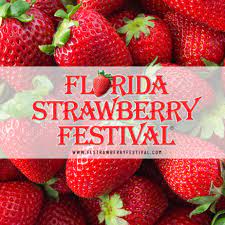Explore the rich history and cultural significance of the renowned Strawberry Festival in Plant City 2024.
The Strawberry Festival in Plant City, Florida, is not merely an event; it's a legacy woven into the fabric of the community and an emblem of the agricultural prowess that defines the region. Taking a closer look at the history behind Plant City's Strawberry Festival reveals a rich narrative of growth, community, and the celebration of the strawberry, which has become synonymous with the area. Here, we delve into the evolution of this beloved festival, highlighting key points that have contributed to its enduring success and cultural significance.
1. The Early Beginnings: A Community Affair
The inception of the Strawberry Festival dates back to 1930. Initially, it was conceived as a way to celebrate the bountiful strawberry harvests of the region. Plant City, thanks to its ideal climate and fertile soil, had become a hub for strawberry farming, and the festival was a means to bring the community together to honor this critical aspect of their local economy and culture. The early festivals were modest, featuring local farmers, community leaders, and families coming together to enjoy the fruits of their labor, quite literally, through strawberry-themed contests, tastings, and displays.

2. The Role of the Lions Club
In 1931, the Plant City Lions Club took over the organization of the festival, transforming it from a small community gathering into a structured event. The involvement of the Lions Club was a turning point, as they introduced more formal entertainment, agricultural exhibits, and contests, laying the groundwork for the festival's growth. Their leadership and vision propelled the Strawberry Festival towards becoming a significant event in Florida's cultural calendar.

3. World War II Hiatus and Resurgence
Like many events nationwide, the Strawberry Festival experienced a hiatus during World War II. This break, however, did not dampen the spirit or the significance of the festival. Post-war, the festival returned with renewed vigor and community support, reflective of a nation's and a community's resilience. This period saw an increased emphasis on not just celebrating the strawberry harvest but also honoring veterans and fostering a sense of unity and patriotism.

4. The Introduction of the Strawberry Queen Pageant
One of the most cherished traditions of the Strawberry Festival is the crowning of the Strawberry Queen and her court. Introduced in the 1930s, the pageant has become a central attraction of the festival, celebrating not only beauty but also community service, academic achievements, and public speaking skills. The pageant embodies the community values and the role of young women in leadership and representation at the festival.

5. Growing Fame and the Celebrity Attraction
As the festival grew in popularity, it began to attract not just local visitors but also tourists from across the nation. By the 1950s and 60s, it had garnered enough attention to attract celebrity performers, further elevating its status as a must-visit event. This introduction of high-profile entertainment helped to diversify the festival's appeal, making it not only a celebration of agriculture but also a significant cultural event.

6. The Festival Today: A Premier Event
Today, the Strawberry Festival stands as one of Florida's most attended events, drawing over half a million visitors annually. Spanning 11 days, the festival is a showcase of agricultural exhibits, crafts, livestock shows, rides, and concerts, epitomizing the community's commitment to celebrating its heritage and economic cornerstone - the strawberry. The modern festival is a far cry from its humble beginnings, yet it remains deeply rooted in the community's spirit and tradition.

- Expanding Horizons: The festival has broadened its scope over the years, incorporating a wide range of activities and attractions that cater to all ages and interests. From thrilling rides at the Midway to educational agricultural workshops, the festival ensures that it offers something for everyone.
- Commitment to Agriculture: Despite its growth and diversification, at its heart, the Strawberry Festival remains a celebration of agricultural excellence. It continues to serve as a platform for farmers to showcase their produce, sharing the story of the strawberry and its significance to the region's economy and identity.
- Community and Volunteerism: The festival would not be possible without the dedication of countless volunteers who come together each year to organize and run the event. This volunteerism is a testament to the festival's role in fostering community pride and cooperation.
7. Economic Impact and Future Prospects
The Strawberry Festival not only serves as a cultural and social event but also as a major economic driver for Plant City and the surrounding region. It stimulates local businesses, generates tourism revenue, and provides a platform for farmers to sell their produce directly to a large audience. Looking ahead, the festival's organizers continue to innovate and expand, ensuring its relevance and appeal in the years to come. This includes incorporating technology, improving infrastructure, and broadening its program to attract a diverse audience while staying true to its roots.

In conclusion, the history behind Plant City's Strawberry Festival is one of community, resilience, and celebration. From its modest beginnings to becoming one of Florida's key cultural events, the festival has grown in size and scope but remains anchored in the traditions that initiated it. As it evolves, the Strawberry Festival continues to embody the spirit of Plant City, celebrating its agriculture, fostering community, and welcoming visitors to partake in its rich heritage and, of course, its delicious strawberries.